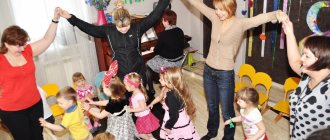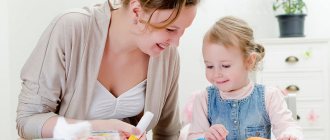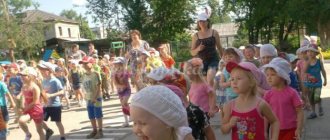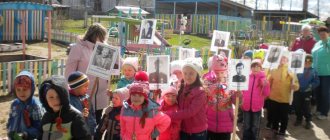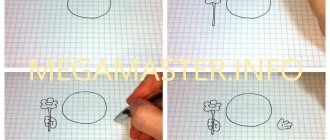Recommendations for parents on the theme of the week “Hello Summer!”
Let's tell the child about summer. Start with the signs of summer: it’s hot in summer, the sun shines stronger (you can put your palms up and bask them in the sun), it’s warm outside, what color is the grass outside, ask your child, at this age he should already know and distinguish the primary colors. Pay attention to the child, what kind of green grass has grown in the clearing, look at the flowers, tell the child what they are called. Perhaps you will see insects in the clearing, tell your child about them. On the street you can meet a beautiful butterfly (you can see its beautiful wings, how gracefully it flies), a ladybug with an unusual outfit and these black dots indicate how old the ladybug is; watch the ant dragging a small stick that is larger than it.
Invite your child to look at the tree, ask what appears on the branches. That's right, leaves, but do you know what color they are? (green). Draw leaves on the tree with your child, and invite the child to find a green pencil in the glass. Show your child how to draw leaves, what shape they should be, pay attention to whether the child is holding the pencil correctly in his hand.
Author: Bortnik Lyudmila Valerievna Position: teacher Place of work: MADOU kindergarten No. 56 of a combined type Location: Petropavlovsk-Kamchatsky
Article Card index of summer conversations in the second junior group. Author: Irincheeva Svetlana Vladimirovna
CARD INDEX OF SUMMER CONVERSATIONS
IN THE SECOND JUNIOR GROUP
1. Conversation “What do we know about summer?” Goal: clarifying children’s ideas about summer; development of logical thinking and long-term memory.
2. Conversation “Vegetables and fruits are a pantry of health.” Goal: to consolidate children’s knowledge about the benefits of vitamins for human health. Inform children that vitamin A (tomato, carrot, onion, apricot..) improves vision; Vitamin C (cabbage, green onions, black currants, lemon) improves appetite.
3. Conversation “A variety of flowers.” Expand children's understanding of the variety of flowers: they can be large and small, round and flat, like bells and stars; they bloom on garden plants, shrubs, trees and herbs; Flower colors include all the colors of the rainbow.
4. Conversation “What is water for?” To develop children’s knowledge about the importance of water in human life; that water exists in the environment in various forms. These include rains, rivers, and seas. In rivers, the water is odorless, tasteless - fresh, pikes and crucian carp live in it... In the sea, the water is salty, and its inhabitants live there - jellyfish, sharks, dolphins and others. Foster respect for water.
5. Conversation about good and evil people. Goal: to reveal the essence of the polar concepts of “good” and “evil”, to show what emotional states they correspond to
6. Conversation “The sun is friend and enemy.” Goal: To form a system of ideas about the sun. Shining and warming are the main functions of the sun. But the sun does not always bring good things (burns, forest fires).
7. Conversation “Pets”. To consolidate children's knowledge about pets and their role in people's lives. To consolidate knowledge about the characteristic features of the appearance, behavior, and lifestyle of domestic animals.
8. Conversation “Forest House”. To give an idea that the forest is the green outfit of our planet. The forest can be coniferous or deciduous. Many plants grow here: shrubs, flowers, mushrooms. Reinforce the knowledge that the forest is a home for animals and birds.
9. Conversation “Air. What is he like? Goal: to consolidate the knowledge that air is what we breathe. It can be clean, fragrant, and sometimes it can be polluted, as in cities, from cars, factories, factories. The air has a smell.
10. Conversation “Beautiful Rainbow”. Goal: to arouse cognitive interest in children, to introduce the sequence of colors.
Memorizing the rhyme “Every hunter wants to know where the pheasant sits.”
11. Conversation “What do we know about insects?” Goal: to clarify children’s knowledge about insects, their diversity, to consolidate the concept of “health”; expand knowledge about preventive measures to prevent diseases and injuries.
children's ideas about summer, summer months; promote the development of agility and endurance.
12. Conversation: “Let’s go along the path into the forest.” Goal: to awaken interest in the forest and its inhabitants; introduce the rules of behavior in the forest and the rules for collecting berries and mushrooms; to arouse a desire to protect the forest and combat violations of the rules of conduct in the forest.
13. Conversation on the topic: “Summer games with children.” Goal: develop conversational speech and the ability to listen to your interlocutor.
14. Conversation: “What is good and what is bad?” Goal: To develop in children the ability to behave in accordance with the requirements of society.
15. Conversation: “How to avoid trouble?” Goal: To introduce the rules of behavior with strangers. Form the basic foundations of the safety of your own life.
16. Conversation: “Happy Summer.” Goal: To introduce children to summer activities and sports. Form ideas about safe behavior in summer.
17. Conversation: “Medicines and vitamins.” Goal: To familiarize children with the dangers of self-use of medications. Form in children the habit of not touching them without the permission of adults.
18. Conversation: “Mirilki.” Purpose: To introduce a variety of sentences - peace orders. Cultivate a desire to resolve conflict situations.
19. Conversation: “Microbes in human life.” Goal: To form children’s ideas about the dangers and benefits of microorganisms on human health. Teach the basics of a healthy lifestyle.
20. Conversation: “What grows in the garden, in the vegetable garden.” Goal: To summarize and systematize children’s knowledge about fruits and vegetables, where they grow, who cares for them.
21. Conversation: “Our little friends.” Goal: Expand children's understanding of insects, their characteristics, and habitats. Form the foundations of ecological culture.
22. Conversation: “Dangerous insects.” Goal: Expand children's understanding of dangerous insects. Learn to distinguish them by appearance.
23. Conversation: “Cleanliness is the key to health.” Goal: To familiarize children with the dangers of poor hygiene. Foster a love of frequency in children.
24. Conversation: “Such different mushrooms.” Goal: To introduce children to edible mushrooms (boletus, chanterelle, boletus) and poisonous ones (fly agaric, toadstool)
25. Conversation: “The bear has mushrooms in the forest, I take berries. Goal: To consolidate children's knowledge about seasonal changes in nature. Form ideas about forest plants: mushrooms and berries. Expand your understanding of the benefits of natural vitamins for humans and animals.
26. Conversation: “Forest dangers.” Goal: Expand children's understanding of poisonous plants. Learn to distinguish them by appearance.
27. Conversation: “Lake Baikal.” Goal: To form an idea of the lake, to cultivate a love for different regions, and a caring attitude towards the surrounding nature.
28. Conversation: “Animals of Lake Baikal.” Goal: To continue acquaintance of children with the inhabitants of Lake Baikal: seal, golomyanka, omul, goby; their appearance and lifestyle.
29. Conversation: “Plants of the Baikal region.” Goal: To form primary ideas about the flora of the Baikal region, about the plants of the mixed forest: cedar, birch, rowan, swimsuit (fry), Daurian rhododendron.
30. Conversation: “If you want to be healthy, toughen up.” Purpose: To introduce the concepts of “Hardening”. Expand children's understanding of a healthy lifestyle.
31. Conversation: “About fire safety rules.” Goal: to introduce children to fire safety rules.
32. Conversation: “Ground transport”. Purpose: To expand understanding of the types of ground transport and its purpose.
33. Conversation: “Water transport.” Goal: Expand understanding of the types of water transport and its purpose.
34. Conversation: “Air transport.” Goal: Expand understanding of types of air transport and its purpose.
35. Conversation: “Russian folk tales.” Goal: To teach children to draw a moral conclusion from the content of fairy tales.
36. Conversation: “Proverbs and sayings.” Goal: Getting to know proverbs and sayings. Introduce to Russian folk art.
37. Conversation: “Children’s folklore.” Purpose: To introduce chants and song appeals to the forces of nature.
38. Conversation: “About books.” Goal: to consolidate children’s knowledge about books; clarifying children’s knowledge about the purpose of books; develop the ability to compare and find similarities and differences.
39. Conversation “Magic words”. Goal: learn to be polite, say hello, say words of gratitude, say goodbye
Summary of the event in the junior group “Hello, red summer”
Goal: Organize festive leisure time and evoke positive emotions.
Tasks:
- Encourage children to play together.
- Enrich children's understanding of the world around them.
- Cultivate a friendly attitude towards each other.
Progress of the lesson
First clearing
The first day of summer is just around the corner! And I’ll tell you not jokingly: Even the sun is shining brighter today And the clouds are floating more cheerfully across the sky!
Both people and birds are so happy about summer, Every animal, bug, and insect is happy about the silent fish in the pond, Happy is the birch tree and happy is the daisy.
Let's sing, have fun, and play. Let's celebrate our favorite summer!
Let's quickly go to the first clearing. Who's there under the bush? There was a little one lurking, in a soft gray fur coat - Well, of course a little bunny.
Hello guys, have you seen a wolf here? I barely got away from him. Well, the bush grew here and hid me. You know that bunnies don't have a house, they live under a bush. Do you know what the houses of wild animals are called? The bear has (den), the fox has (hole), the wolf has (den), the beaver has (hut). You are so smart. Let’s play and dance “Show yourself, little gray bunny...”.
Second clearing
But in the second clearing there is a top, but what are these guys - why did he put on a doctor’s robe?
Hello, who are you? You must be bunnies! Then you are bear cubs! Maybe you are piglets! What about you guys? And I am a forest orderly - Wolf. Now I don’t offend anyone, but quite the opposite - I care about the health of forest inhabitants. So I ran after the bunny, I wanted to give him some vitamins, but he ran away. Do you like cleanliness? Are your hands clean? Are your ears clean? Are your teeth clean? Well then, I’ll teach you how to do exercises so that you are healthy and strong. Fun exercise to the music “The giraffe has spots...”.
Third clearing
Here the third clearing meets us, and there the fox is waiting.
Oh, how good you are! Oh, how beautiful you are! I’ll check you now to see how attentive you are. (game with hoops)
In my clearing, many friends gathered. You frolic and play, don't run far,
And when the tambourine sings, he will call you to the house. Red, blue, yellow house - Remember which one you live in.
"Hello summer!"
Project activities in the second junior group on the topic:
"Hello summer!"
Performed:
teacher of the second junior group
"Sunny bunnies"
Voinova Daria Sergeevna
Zverevo 2017
Project problem:
children who are just beginning to learn about the world around them have little idea about the natural phenomena of animate and inanimate nature, including summer. It is at the age of 3-4 years that children most often have questions - why and why? In conversations, children cannot answer many questions themselves, for example: Why do we need the sun? Where do puddles come from? Why do you need rain? In order to develop children's knowledge about seasonal natural phenomena, this project was developed.
Objective of the project:
developing children's knowledge about seasonal phenomena of living and inanimate nature.
Project objectives:
- Teach children to notice summer changes in nature;
- To develop in children the ability to listen and understand literary words;
- Keep children interested in experimenting. Learn to draw simple conclusions;
- To form in children ideas about the relationship between nature and man;
- Teach children to see the extraordinary beauty of nature and enjoy the world around them;
- Develop observation, creative imagination, voluntary memory and attention.
- To instill in children an interest and respect for nature;
- Enrich children's vocabulary with new words.
- Preparatory stage:
Forms of working with children:
- Conversations with children to identify children's knowledge about summer.
- Reading and memorizing poems, nursery rhymes, riddles about summer, looking at illustrations, paintings about summer;
Forms of work with parents:
- Consultation;
- Mobile folders;
- Home creative assignments.
- Main stage:
- Project implementation work plan;
- Contents of working with children.
Monday: work with the weather calendar every day. Learning the article by I. Surikov “Summer”, sub-game “Bees dance in a circle”, recreational running around the site. Gymnastics after sleep “The sun woke up”, reading the fairy tale “The sun is visiting”, sub-game “Sun and rain”.
Working with parents:
Selection of material for the photo exhibition “Summer in Nature”.
Tuesday: conversation “Merry Sunshine”, finger. Gymnastics “Rain”, observation “Operation Sun!”, fun game with windmills. Board game “Collect a picture about summer”, water game “Fishermen”, observation “In the shade and in the sun”, entertainment with soap bubbles.
Working with parents: drawings with children on the theme “Me and Summer.”
Wednesday: observation “Plants in the garden”, reading “Dandelion”, game “Collect a flower”, round dance game “Wreath”. Observation “Flower bed plants in the heat”, work assignments “Let’s water the plants”, board game “Mosaic (“Lay out a flower”).
Thursday: observation “Birds in the Nest”, fun game “Light Feather”, reading “Where the Sparrow Dined”, coloring book on the theme “Summer”. Conversation “Insects benefit and harm”, finger. Gymnastics “Flowers and Insects”, game “Match the wings of a butterfly”.
Working with parents: consultation “Educational games with children in the summer.”
Friday: round dance game “Kindergarten Near the River”, storytelling based on the painting “Children Playing in the Sand”, reading “How Much Rain I Know”, experimentation “Dry and Wet Sand”, art. Creativity “Drawing on wet sand.” Riddles about summer phenomena in nature, listening and singing children's songs about summer, watching the cartoon "Santa Claus and Summer."
Results of the project:
- Exhibition of children's works “Me and Summer”;
- Photo exhibition “In summer in nature”.
Reflection: within the framework of the project, the work turned out to be educational. Children mastered and comprehended new knowledge acquired with the help of parents and educators. We learned to draw specific, simple conclusions. We realized that we need to protect nature, admire it, and not destroy it. The children shared new information with interest. Demonstrated the ability to experiment independently and the desire to independently search for the right solution. We received a number of positive emotions in the process of their creative interaction and artistic and active communication with adults. Parents took an active part in the project and were interested in its results.
